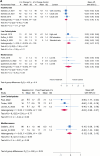Dietary Patterns for Weight and Glycemic Management in Persons With Type 1 Diabetes: A Meta-analysis of Clinical Trials
- PMID: 40795275
- PMCID: PMC12527424
- DOI: 10.1210/clinem/dgaf448
Dietary Patterns for Weight and Glycemic Management in Persons With Type 1 Diabetes: A Meta-analysis of Clinical Trials
Abstract
Background: Medical nutrition therapy is fundamental for managing glycemia and weight in type 1 diabetes, yet dietary guidance specific to this population and relevant subgroups is lacking.
Purpose: We synthesized the interventional literature investigating diet patterns for glycemic and weight management in youth and adults with type 1 diabetes, with attention to interindividual variation that suggests the need for precision approaches. The protocol was prospectively registered (CRD42024519941).
Data sources: AMED, CINAHL, Cochrane Library, Ovid MEDLINE, Ovid Embase, Google Scholar, and Web of Science Core Collection were searched from January 2011 to June 2024.
Study selection: Clinical trials ≥4 weeks with ≥10 youth and/or adults diagnosed with type 1 diabetes ≥6 months prior and reporting glycated hemoglobin (HbA1c) or weight were included.
Data synthesis: Twelve studies with 668 participants were included. Data were pooled by random-effects models for HbA1c and weight. Studies with insufficient data and subgroup differences were narratively synthesized per Synthesis without meta-analysis guidelines. Pooled results of very low to moderate certainty evidence showed no advantage of any particular diet pattern in randomized trials. Very low-quality evidence from single-arm low carbohydrate trials suggested improved HbA1c over time (-0.63% [95% CI, -0.99 to -0.27]; -6.0 mmol/mol [-10.8 to -3.0]). Wide pooled CIs suggested between-person heterogeneity; however, stratification of results by participant characteristics was rarely performed.
Limitations: Limited evidence precluded subgroup analyses to inform precision nutrition approaches.
Conclusion: Randomized trials are needed to confirm the efficacy of specific diets and determine whether precision nutrition therapies optimize glycemia and weight in persons with type 1 diabetes.
Keywords: diet patterns; hemoglobin A1c; meta-analysis; systematic review; type 1 diabetes; weight.
© The Author(s) 2025. Published by Oxford University Press on behalf of the Endocrine Society.
Figures



References
-
- Purnell JQ, Braffett BH, Zinman B, et al. Impact of excessive weight gain on cardiovascular outcomes in type 1 diabetes: results from the diabetes control and complications trial/epidemiology of diabetes interventions and complications (DCCT/EDIC) study. Diabetes Care. 2017;40(12):1756‐1762. - PMC - PubMed
Publication types
MeSH terms
Substances
Grants and funding
LinkOut - more resources
Full Text Sources
Medical

